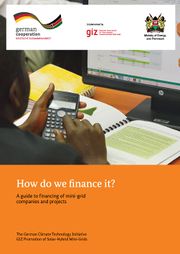Knowledge fuels change
For over a decade, Energypedia has shared free, reliable energy expertise with the world.
We’re now facing a serious funding gap.
Help keep this platform alive — your donation, big or small, truly matters!
Thank you for your support
Mini-Grid Financing
Overview
and basic recommendations for securing various forms of financing for the most relevant types of mini-grid businesses and projects in Kenya. It serves to provide an overview of mini-grids and the key financing concepts and procedures that developers should consider when developing mini-grid projects. The handbook eases the understanding of the most relevant aspects of financing mini-grids and sheds light on the financing process, options and timings for project developers. It presents an overview of typical (simplified) investment cases, giving corresponding illustrations of tariff structures and key considerations for financing methods for each case.
The guidebook is targeting (prospective) mini-grid developers who seek to get a general understanding of financing a mini-grid in Kenya but can also serve as a reference to other stakeholders. It, therefore, offers a general introduction to mini-grid financing in Kenya and is not targeting mini-grid financing experts and companies already engaged with financing mini-grids.While this handbook intends to display the required knowledge for mini-grid financing, mini-grid projects are very site specific. The authors of this handbook, therefore, do not accept any liability for commercial or investment decisions taken on the grounds of the knowledge presented within.
The handbook is the most recent addition to a series of publications by ProSolar for mini-grid practitioners, coming after a practical guide to mini-grid site selection, licensing and sizing.
Table of Contents
Link of the guidebook: Mini-Grid Financing Guidebook
- Introduction 10
- Understanding Mini-Grid Financing 12
2.1. Basic Finance Principles 12
2.2. Corporate vs. Project Financing 14
2.3. The Different Pools of Money in Global Finance 15
2.4. Types of Financing and their Considerations 21
2.5. Stages of Financing 23
2.6. Types and Timing of Financing for Mini-grid Projects 28
2.7. What Investors Value in Companies they Invest In 30
3. Kenya Mini-Grid Market Overview 34
3.1. Market size and relevant actors 34
3.2. Framework conditions 35
3.3. Financing Mini-Grids in Kenya 37
4. Solar-Hybrid Mini-Grid Business Models and Cost-structures 40
4.1. Case 1 - Micro-Grid 43
4.2. Case 2 - Isolated Mini-Grid 47
4.3. Case 3 - Small Power Distributor 51
5. How to Apply for and Secure Financing for Mini-Grid Developers 56
5.1. Financing Steps for Mini-grid Developers 57
5.2. Challenges for securing finance 72
6. Conclusion 73
Annex 75
Kenya Mini-Grid Market Overview: Market Size and relevant actors
The National Rural Electric Cooperative Association (NRECA) estimates the off-grid market in Kenya to consist of around 1 million households, many of which can best be served <g class="gr_ gr_105 gr-alert gr_gramm gr_inline_cards gr_run_anim Grammar <g class="gr_ gr_119 gr-alert gr_spell gr_inline_cards gr_run_anim ContextualSpelling ins-del multiReplace" id="119" data-gr-id="119">multiReplace</g>" id="105" data-gr-id="105">with</g> solar home systems. Around 280 clusters of more than 50 structures, which are suitable for mini-grids, have been identified through a satellite mapping in the off-grid area. Considering smaller communities will result in a significantly larger amount of communities that can be served by micro-grids. Furthermore, mini-grids in grid-proximity can be a viable option in case the potential future grid integration is part of the business model.
There are currently 21 mini-grids in operation under a public model, of which 19 are owned by the Rural Electrification Authority (REA) and operated by KPLC and 2 are owned and operated by the Kenya Electricity Generating Company (KenGen). These mini-grids are predominantly diesel fuelled, some of which have smaller solar or wind components. There are plans to retrofit and hybridize all existing systems with renewable energy components. The isolated mini-grids operated by KPLC currently have about 20,000 connections in total (less than 0.5% of the Kenyan population). The total installed capacity for these mini-grids is 24.8 MW comprising of 23.7 MW thermal, 0.55 MW wind, and 0.57 MW solar. The stations operated by KenGen are located in Garissa and Lamu. Lamu was recently connected to the national grid, and construction is being undertaken to also connect Garissa to the national grid. Additionally, NGOs, communities, and academia have developed small mini-grids. <g class="gr_ gr_126 gr-alert gr_gramm gr_inline_cards gr_run_anim Punctuation only-ins <g class="gr_ gr_121 gr-alert gr_spell gr_inline_cards gr_run_anim ContextualSpelling ins-del multiReplace" id="121" data-gr-id="121">replaceWithoutSep</g>" id="126" data-gr-id="126">Also</g> several private firms in Kenya are developing these mini-grids in small but densely populated areas, sometimes just next to the main grid. These sites differ greatly from the utility scale approach of KPLC in that these mini-grids are based on renewable energy (mostly solar), they are relatively <g class="gr_ gr_127 gr-alert gr_gramm gr_inline_cards gr_run_anim Punctuation only-del <g class="gr_ gr_123 gr-alert gr_spell gr_inline_cards gr_run_anim ContextualSpelling ins-del multiReplace" id="123" data-gr-id="123">replaceWithoutSep</g>" id="127" data-gr-id="127">mobile,</g> and cover smaller radiuses with low voltage distribution.[1]
- Read more about framework conditions and financing options in Kenya in Chapter 3.
Further Information
This guidebook has been developed as part of a series of handbooks on mini-grids. You can access the other ones on the following web pages:
- GIZ-ProSolar. What size shall it be? A guide to mini-grid sizing and demand forecasting. August 2016.
- GIZ-ProSolar. How do we license it? Lessons learned from the application for power generation and distribution for the Talek Power Solar Mini-Grid project. July 2015.
- GIZ - ProSolar. Where shall we put it? Solar mini-grid site selection handbook. June 2014.
- ProSolar 2016 fact sheets: ProSolar project, Mini-Grids Result Based Funding (RBF) project.
References
- ↑ Ross, David. ‘How Do We Finance It. A Guide to Financing of Mini-Grid Companies and Projects’. The German Climate Technology Initiative GIZ Promotion of Solar-Hybrid Mini-Grids, 2017. https://energypedia.info/images/4/40/How_do_we_finance_it%3F.pdf.




















